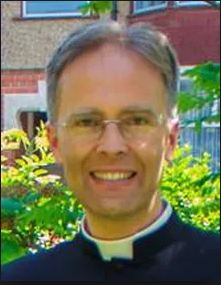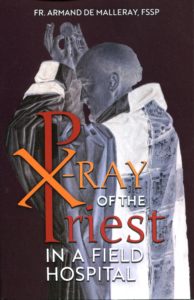X-Ray of the Priest: Interview with Fr. Armand de Malleray
 We are pleased to present an interview with Fr. Armand de Malleray, FSSP, of Warrington, England on his new book X-Ray of the Priest in a Field Hospital (Arouca Press, 2020).
We are pleased to present an interview with Fr. Armand de Malleray, FSSP, of Warrington, England on his new book X-Ray of the Priest in a Field Hospital (Arouca Press, 2020).
+ + +
Q: Thank you, Father, for taking time to answer some of our questions. First of all, who is this book aimed for? Just priests, or the laity as well?
A: Priests first. I give retreats to priests every year, most of them diocesan. They are fond of discovering the riches of the traditional philosophy, theology and spirituality. Of course most priests would know some of this teaching, but because of our traditional formation, we FSSP priests are in a good position to explain the beautiful connection between liturgy, philosophy, theology and spirituality. It’s a priestly package. It makes sense to priests who come across it. Even though it’s a bit daunting at first, seen from without, it rings very true and gives hope to priests who struggle in their ministry and in their priestly identity.
But X-Ray of the Priest is also for the laity. Lay people support us clergy through their alms, prayers, sacrifices and affection – as we know well with the 7,000 members of the Confraternity of St Peter, among others. The more the laity understand what the priesthood is about, the better they can safeguard, encourage and follow their pastors.
 Q: The beginning of your book is an arresting and sobering description of 14 Stations of Priestly Apostasy, set against the backdrop of the 2016 film Silence. How does someone with the grace of the priesthood fall so low as to gravely sin, or even commit crimes?
Q: The beginning of your book is an arresting and sobering description of 14 Stations of Priestly Apostasy, set against the backdrop of the 2016 film Silence. How does someone with the grace of the priesthood fall so low as to gravely sin, or even commit crimes?
A: There have been bad priests from the beginning, starting with Judas. What one could term the ‘Tridentine’ model of the priesthood offered customs and rules protecting the priest in his daily life. It was abandoned in the 1960s. We FSSP priests are privileged to use again most of these practices. They don’t make us impeccable, of course, since we are sinners like every one else. But they help us exercise prudence. Philosophers say ‘Agere sequitur esse’ – or ‘One behaves according to who one is’. Many modern priests have a very hazy understanding of who they are as priests. Priests are other Christs whose souls were substantially modified through the imprint of the priestly character, enabling them to posit sacred actions such as, chiefly, offering the Holy Sacrifice of the Mass and reconciling penitents in Confession. Everything else in what a priest does is secondary. The more a priest realizes this truth, the more fulfilled he is in his relationship with God, hence the less gravely he is likely to fall.
Q: You cite a very extraordinary man named Karl Lesner, who was actually ordained a priest in the Dachau concentration camp. What lessons does his life offer us today?
A: Our FSSP European seminary in Wigratzbad is located in Bavaria, not far from the concentration camp of Dachau. It brought Karl’s virtues closer to us. Karl was an ordinary young man. Nazi persecution tested his priestly vocation to its utmost limit. By God’s grace, he triumphed. I think his traditional formation had given him a very clear grasp of what the priesthood is about. Union with Christ is key, especially in times of trial. This applies to all men, but especially to priests, empowered and mandated by Christ and His Church to be models of the flock and shepherds of souls. Karl persevered in answering his priestly call even amidst the horror of Dachau (the largest priestly cemetery in the world). His example proves fidelity possible for any priest, even though parish life is difficult at times; and despite the opposition from the world to priestly sanctity.
Q: You make a fascinating analogy between the Shroud and the unfolding or development of doctrine. Why does God reveal doctrine gradually, instead of all at once?
A: We humans live in time. Adapting His communication to our condition, God reveals Himself to us gradually. He did so in the Old Testament through the Patriarchs, the Prophets and kings. He continues to reveal Himself by stages to us in the Christian era. He wishes our free collaboration. That is why He endowed us with understanding and free will after His image and likeness. Our interest and perseverance please Him. By analogy, it is like a father who provided a beautiful and costly present for his little boy: unwrapping it takes time; but that time is not wasted, rather, it demonstrates love shared. Only, in the case of God the Father, His Gift to us is His Son, Jesus.

Q: In light of your description of the “sensus fidei” as the sheep who follow the Good Shepherd to know and hear His voice, how do we balance obedience to the deposit of the faith with obedience to the clergy, when these appear to conflict?
A: We have highly reliable books to guide us, such the Catechism of the Council of Trent, the various traditional books of theology and spirituality (e.g. by Fr Reginald Garrigou-Lagrange OP) and so many enlightening encyclicals such as Casti Connubii, Mystici Corporis, Fides et Ratio or Ecclesia de Eucharistia. God expects us to use the intellect He gave us to assess whether a homily or a parish bulletin is consistent or not with what Holy Mother Church has believed and professed everywhere and always. We may respectfully request clarification from our pastors if some of their statements are unclear, or even inaccurate. The Tenth Rule for Thinking with the Church by St Ignatius Loyola recommends:
“To be eager to commend the decrees, mandates, traditions, rites and customs of the Fathers in the Faith or our superiors. As to their conduct; although there may not always be the uprightness of conduct that there ought to be, yet to attack or revile them in private or in public tends to scandal and disorder. Such attacks set the people against their princes and pastors; we must avoid such reproaches and never attack superiors before inferiors. The best course is to make private approach to those who have power to remedy the evil.” If a scandal is obvious and grave though, a quicker reaction might be needed, if prompted by the Spirit of Truth and Charity.
Q: You devote quite a bit of your book to the feminine archetypes of Eve and the Blessed Virgin, and to bridal imagery. How do these connect with the priesthood?
A: Our Lord is the Bridegroom and Holy Church is His mystical Bride. In the sacrament of Matrimony, husband and wife echo this mystical complementation. The priest stands and acts in the Person of Christ in relation to the particular flock entrusted to his care. Priestly celibacy is best understood in this light. The priest renounces the legitimate joys of marriage and family so as to manifest his total availability in the service of the group of souls put under his responsibility by his ecclesiastical superior.
Q: The end of the book drives home the historical importance of religious orders. Do you see a need for their revival? And what is the young laity’s role in that?
A: The fourth of the Rules by St Ignatius quoted above states: “To have a great esteem for the religious orders, and to give the preference to celibacy or virginity over the married state.” I am sure that this is a bit shocking even for traditional Catholics. We need to recover the precedence of the consecrated state over married life. Sure, we need many strong Catholic families. But no less do we need to revive failing religious orders. In fact, both grow together: strong religious life makes strong families, and vice-versa. When reviving a dying monastery doesn’t work, then by God’s inspiration and grace, the young people must found new orders. Needless to say, they will prosper only to the extent in which they will draw from the wisdom and experience of the glorious orders of old such as the Benedictines, the Dominicans, the Carthusians, the Carmelites, the Jesuits etc.
+ + +
Fr. de Malleray’s X-Ray of the Priest in a Field Hospital is available from Fraternity Publications. Also by the same author is a book on the Holy Eucharist with a foreword by Bishop Athanasius Schneider: Ego Eimi – It is I, Falling in Eucharistic Love: Reflections on the Sacrament of the Most Holy Eucharist.
September 11, 2020








